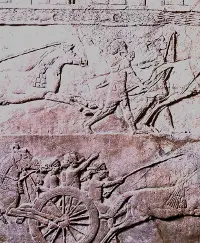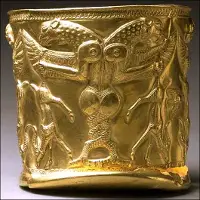The Elamites
The Elamite civilization arose in what is now Iran in antiquity and was known to people who lived in Mesopotamia. The Elamites are known to have come into contact and conflict with the Sumerians and the Akkadians. 
Its capital was Susa, thought to have been founded about 4000 B.C., on the river Karun. What came to be known as the Elamite civilization was the result of the consolidation of a handful of other smaller settlements, among them Anshan, Awan, and Shimashki. Historians know of a treaty into which Elam and the Akkadian king Naram-Sin entered, in the 23th Century B.C. The Babylonians gained the upper hand a few centuries later and conquered Elam, ruling it for a time. Elam, returning the favor, pounced on a weakened Ur, sacking it in 2004 B.C. This was effectively the end of the once proud Sumerian civilization, originators of so many of civilization's early inventions. 
Records from the Babylonian tradition tell of a victory by the Akkadian emperor Sargon over Awan and of Sargon's rule over Susa. Elam was ascendant again not long afterward and remained so for a time. In the see-saw pattern of ascendancy that punctuated many ancient cultures, Elam reigned supreme but then fell victim to another neighboring aggressor, the Amorites, whose famous king Hammurabi led an army that soundly defeated the forces of Elam in 1764 B.C. Taking advantage of the chaos that resulted from the death of that king, Elam struck back, under King Kutir-Nahhunte I, and gained independence once again. Historians know little about the Elamite civilization for the next few centuries until it comes into conflict with another aggressive neighbor, the Assyrians. One particularly successful Elamite king, Khumbannumena, was so successful at conquering neighboring lands that he was given the title "Expander of the Empire." One of his successors, Shutruk-Nahhunte, captured Babylon and brought back to Susa the famous law code of Hammurabi. Through the years, Elamite lands were also occupied by another neighboring people, the Kassites, who also occupied Babylonia for a time. Some historians list the Elamite kings in terms of dynasties, beginning with the Awan Dynasty in the 23rd Century B.C. Elamite kings proved very effective at having sons and then passing power to them peacefully. 
When the Elamites were not conquering their neighbors or defending themselves against attacks, they engaged in trade, not only with Mesopotamia but also with the Indus River Valley civilization. Trade with the latter fell away when that civilization disappeared. The Elamites were known to have their own language and their own religion, which was polytheistic. Some Elamite art, notably statues and vases, has survived. The major Elamite city was Susa, the capital. That city was the target of a military expedition by the Assyrian leader Ashurbanipal in the 7th Century B.C. The Assyrians were devastatingly effective in their conquest, sacking the city and reducing it to rubble. The civilization carried on in a reduced fashion, rising again briefly after the Assyrians met their own demise. With the advent of the empire of Cyrus the Great, the Elamites ceased to exist in their own independent way. |
|
Social Studies for Kids
copyright 2002–2024
David White




